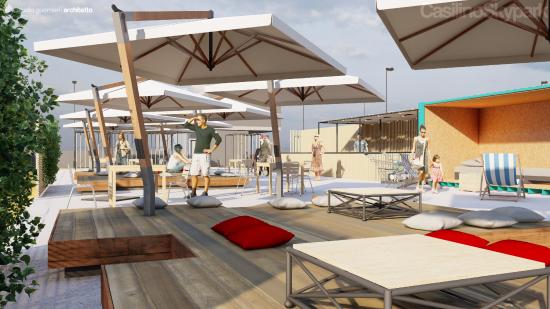Each shopping center should be kept up with the new consumer trends and the needs of the catchment areas

In the Business Plan 2022-2024 presented last December, IGD mapped out some precise guidelines relative to the merchandising and tenant mix which were already applied for the first time during the remarketing of the vacancies stemming from the pandemic.
The work done to ensure that each shopping center keeps up with the new consumer trends and the needs of the catchment areas, is combined with a rethinking of the layouts, as well as a new marketing strategy which leverages on the opportunities that digitalization provides.
Let’s find out more by speaking with Laura Poggi who, as of 1 January was appointed Director of the Commercial Department, Marketing and CSR, after already spending several years in IGD as head of leasing.
Let’s start by talking about the commercial strategy for the next few years. What are the main actions that you will take?
The priority in this Plan also, is to protect occupancy, even more in a moment as delicate as the current one, while respecting returns: good occupancy is, in fact, essential to the ability to make any significant improvements. Beginning with the underlying objective of ensuring the assets are capable of meeting the challenges posed by changing consumption, our intention is to accelerate change in the merchandising mix across the entire portfolio in order to scale up models we have already tested in a few shopping centers where several emerging brands were introduced, along with new formats. One of the cornerstones of this policy is to expand the range of services offered. For this we are working on opening two medical centers already in 2022, along with the introduction of a whopping 6,000 new square meters in fitness centers that will be opened this year. The work on updating the formats of the restaurants in our food courts is also continuing: we have seen that, even though it is one of the sectors hardest hit by the Covid-19 restrictions, restaurants have been particularly reactive and aware of the new concepts that consumers now prefer, increasingly more focused on fresh, healthy food. This is why we have taken advantage of the new passions for Hawaiian and organic dishes, as well as high quality cuisine, and have already contracted more than 1,600 square meters in new food choices and others are in the works. Particular attention will also be paid to adding stores dedicated to homecare, family stores, sporting goods and tech, all categories that recorded excellent performances in 2021.
Will the spaces need to be redesigned to make room for the “new entries”?
Without a doubt. In order to accommodate the new arrivals, we will have to reduce, where possible, the size of the hypermarkets in order to create areas dedicated not only to sports, but also to smart working, entertainment, by also using the outdoor areas, building rooftops, like at Casilino Sky Park, and part of the areas that today are used for parking. The shopping centers, overall, will have more green zones.
Will the approach to marketing also change?
Certainly. In addition to changing the merchandising mix, we will also have to work hard on the development of co-marketing with the tenants in order to define targeted offers based on the new CRM systems. Over the last two years the smartest retailers have invested a lot in improving customer relations and in developing omnichannelism, in order to ultimately guide the completion of the purchase to the store which is still considered a key part of the purchase process and where the service and the experience are still a strong attraction.
How have you actually structured the digital change?
IGD had launched a Digital Plan in 2020, as it had already hired a Digital Strategist in 2019. In 2021 we moved forward with the Plan, integrated the existing instruments and made new ones available in order to provide the visitor with the opportunity to be in touch with the Shopping Center both digitally and physically during all the legs of the customer journey. The implementation of the Customer Relationship Management (CRM) system was key to the work carried out and helped to combine the different tools included in the system in a direct or indirect dialogue with the CRM system itself. The CRM system now, therefore, speaks directly with the websites (which were subject to a complete restyling in the first part of the year), the wi-fi, the digital totems and the new Area Plus, an exclusive space on the websites dedicated to the visitors of our structures, with products, content, services, special offers and gaming. With this work we succeeded in meeting our first expectations: begin communicating directly with our visitors, telling them about what happens in our shopping centers and the opportunities being offered to them.
We will be able to provide these individuals, and those who interact in the next few months, with a personalized experience inside each shopping center based on the preferences they have shared.
So you are moving towards a shopping center that speaks to people in a more direct and personalized way with people…
That’s right. We will have a marketing plan that will be more widespread across the region; where we are able to build a digital community, we will, in fact, be organizing an event. But this is not the only area we are working on. We would like to see that, more and more, the Shopping Center is able to meet the individual needs of our visitors. For this reason, including thanks to the opportunities that digital provides, we intend to deepen the partnership with the tenants in order to agree on offers and opportunities that leverage increasingly on omnichannelism.
What is IGD’s role in this path?
As the owner of the shopping centers, IGD is the facilitator of this process.
In 2021 we began an interesting engagement process with our retailers which now we intend to continue and deepen as a result of the approach we talked about before. This represents a new approach to our marketing, with increasing integration between what happens in the malls (events, exhibits, sweepstakes, etc.) and what is defined in the digital world.
What were the most important developments in 2021?
Tenant sales provide a first, very encouraging result. In the period June – December 2021tenant sales were, in fact, in line with the same period of 2019, despite the 19% decrease in footfalls. With regard to occupancy, we closed with a very reassuring figure of above 95% as a result of a very intense re-letting process: 25 thousand square meters was remarketed in the year against the vacancy of 23 thousand square meters created due to the pandemic. We also took advantage of the situation to make the changes in the merchandising and tenant mix called for in our commercial strategy: in this way we increased the weight of homecare, reducing the overall space dedicated to apparel, while also revisiting the different fashion sub-categories. This was an important change, even if the full benefits will be seen in coming years.
How did 2021 close, considering the scope of the Omicron variant?
Even though the last wave of COVID-19 impacted December sales and the beginning of end of the year sales in January, we will continue to be very focused on implementing our programs over the next few months so that 2022 is a good year to embark on the path called for in the Plan. We are, therefore, counting on the fact that as the infection rates normalize footfalls, which also lacked the support of organized events, will recover.
What is the biggest challenge for 2022?
If, in 2021, we were satisfied that we were able to maintain occupancy at 95%, in 2022 we will monitor the unfolding of the complicated global market and geopolitical situation of these past few weeks, well aware of how important it will be to pay constant attention to the balance and sustainability of our tenants and our malls over the next few months. The challenge for 2022 is to return to pre-pandemic levels, even though it is clear that the next two percentage points we need to recover represent a very challenging part of the path. For this reason, we can’t waste time and we have to implement our commercial policy in a timely manner. If, at year-end 2022, we will have returned to 2019 levels, in 2023 we will be able to aspire to a greater transformation of the shopping malls, based on an analysis which takes into account the primary catchment area of each center. We will work, at that point, on asset management initiatives and marketing, developed and fine-tuned for each asset, which requires a lot of hard work, but which, for us, is also very stimulating.
Share




